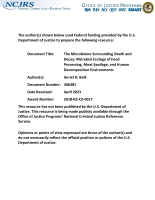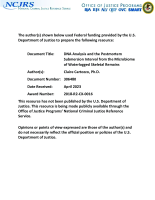Showing Results For:
Subtopic: Microbiomes
Rethinking the Roles of Pathogens and Mutualists: Exploring the Continuum of Symbiosis in the Context of Microbial Ecology and Evolution
Date Published
2022
Journal
Phytobiomes Journal
Agencies
NIJ-Sponsored
DNA Aptamer–Cyanine Complexes as Generic Colorimetric Small-Molecule Sensors
Date Published
2022
Journal
Angeewandte Chemie
Agencies
NIJ-Sponsored
The Human Virome as Trace Evidence in Forensic Investigation
Date Published
2022
Agencies
NIJ-Sponsored
Transcriptomics Reveals the Putative Mycoparasitic Strategy of the Mushroom Entoloma abortivum on Species of the Mushroom Genus Armillaria
Date Published
October 2021
Journal
Msystems
Agencies
NIJ-Sponsored
Population Informative Markers Selected Using Wright's Fixation Index and Machine Learning Improves Human Identification Using the Skin Microbiome
Date Published
September 2021
Journal
Applied and Environmental Microbiology
Agencies
NIJ-Sponsored
A Pilot Study of Microbial Succession in Human Rib Skeletal Remains during Terrestrial Decomposition
Date Published
July 2021
Journal
mSphere
Agencies
NIJ-Sponsored
Naturalization of the Microbiota Developmental Trajectory of Cesarean-born Neonates after Vaginal Seeding
Date Published
June 2021
Journal
Med
Agencies
NIJ-Sponsored
The Forensic Microbiome: The Invisible Traces We Leave Behind
Date Published
June 2021
Agencies
NIJ
The Microbiome Surrounding Death and Decay: Microbial Ecology of Food Processing, Meat Spoilage, and Human Decomposition Environments
Date Published
2021
Agencies
NIJ-Sponsored
Aptamer-Integrated Multianalyte-Detecting Paper Electrochemical Device
Date Published
2021
Journal
ACS Applied Materials & Interfaces
Agencies
NIJ-Sponsored
Root and crown rot pathogens found on dry beans grown in Mozambique
Date Published
2021
Journal
Tropical Plant Pathology
Agencies
NIJ-Sponsored
Forensic Microbiome Database: A Tool for Forensic Geolocation Meta-Analysis Using Publicly Available 16S rRNA Microbiome Sequencing
Date Published
2021
Journal
Frontiers in Microbiology
Agencies
NIJ-Sponsored
Associations Detected between Measures of Neighborhood Environmental Conditions and Human Microbiome Diversity
Date Published
November 2020
Journal
Science of the Total Environment
Agencies
NIJ-Sponsored
DNA Analysis and the Postmortem Submersion Interval from the Microbiome of Waterlogged Skeletal Remains
Date Published
July 2020
Agencies
NIJ-Sponsored
Using Microbiome Tools for Estimating the Postmortem Interval
Date Published
2020
Agencies
NIJ-Sponsored
Inferring directional relationships in microbial communities using signed Bayesian networks
Date Published
2020
Journal
BMC Genomics
Agencies
NIJ-Sponsored
Effects of Extended Postmortem Interval on Microbial Communities in Organs of the Human Cadaver
Date Published
2020
Journal
Frontiers in Microbiology
Agencies
NIJ-Sponsored
The gut microbiome and neuropsychiatric disorders: implications for attention deficit hyperactivity disorder (ADHD)
Date Published
2020
Agencies
NIJ-Sponsored
Dysbiosis in the Dead: Human Postmortem Microbiome Beta-Dispersion as an Indicator of Manner and Cause of Death
Date Published
2020
Journal
Frontiers in Microbiology
Agencies
NIJ-Sponsored
Detecting personal microbiota signatures at artificial crime scenes
Date Published
2020
Journal
Forensic Science International
Agencies
NIJ-Sponsored
Characterizing the postmortem human bone microbiome from surface-decomposed remains
Date Published
2020
Journal
PLoS ONE
Agencies
NIJ-Sponsored
Microbial Clocks for Estimating the Postmortem Interval of Human Remains at Three Anthropological Research Facilities
Date Published
2020
Agencies
NIJ-Sponsored
Microbial Similarity between Students in a Common Dormitory Environment Reveals the Forensic Potential of Individual Microbial Signatures
Date Published
July 2019
Journal
mBio
Agencies
NIJ-Sponsored
Detection of Critical Antibiotic Resistance Genes Through Routine Microbiome Surveillance
Date Published
2019
Journal
Frontiers in Microbiology
Agencies
NIJ-Sponsored
The Impact of Skin Care Products on Skin Chemistry and Microbiome Dynamics
Date Published
2019
Journal
Bmc Biology
Agencies
NIJ-Sponsored
Research Forensic Library
We invite you to also search the Research Forensic Library, a curated collection of publicly-accessible material relating to every discipline of the forensic sciences.





